Monarchs are usually obsessed with sons. To beget them, they are ready for divorces and international disputes. However, in what is said to be a state of mind, heirs to the throne could expect insults, beatings, and even cruel death. From the hands of their own fathers ...
Ivan the Terrible and Peter the Great are two reformers known for their ruthlessness and cruelty. However, they had much more in common than just the style of exercising power…
Terrible father, father-in-law and grandfather
Tsarevich Ivan Ivanovich was an almost faithful copy of his violent father. In this most gifted son, Ivan the Terrible saw a worthy successor. Despite this, the boy experienced a heavy paternal hand more than once . The Tsar was afraid that the Tsarevich and the Romanovs were going to overthrow him. When the boy was seventeen, he even publicly announced his intention to disinherit him.
Quarrels in the tsarist family broke out for various reasons. A despotic father meddled in his son's family affairs. It was he who locked the heir's first two wives in the convent. The tsar severely beat the pregnant third daughter-in-law for finding her in only one shirt . And since the woman was considered fully dressed at the time, when she wore two more, he became furious as if she was in a nude.
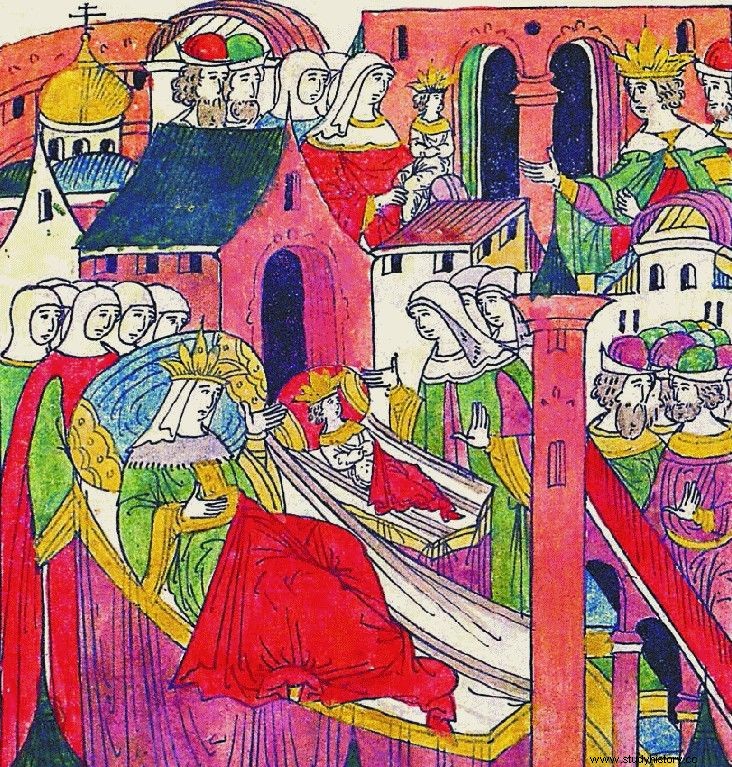
This is how the birth of Ivan, son of Ivan the Terrible, was depicted in such a cheerful and colorful way. The Tsarevich did not have the opportunity to be so happy about the birth of his own son ... Miniature from a 16th-century chronicle (source:public domain).
As a result of the injuries, my daughter-in-law had a miscarriage. The next day the tsarevich told his father that he had not only deprived him of his two previous wives, but also an heir. The quarrel turned into a fight, during which the tsar hit his son in the temple with a scorch - a cane with a metal ferrule . According to another version of the events, young Ivan was hit because he wanted to go to the rescue of Pskov, besieged by Batory.
End of the dynasty at your own request
The Tsarevitch lost consciousness and fell to the ground. The tsar's anger turned to despair. He tried to stop the blood, but even the doctors couldn't help. Young Ivan died after a few days of fever on November 19, 1581.
After the death of his son, the tsar watched over the body for three days . In the funeral procession, he was dressed in monks' clothes. He vented despair at the Council of Archangel, where his son's body was buried. He cried, threw himself at the coffin, complained about his violence.

Ivan IV the Terrible watches by his son's marauds. The son he had killed himself. A painting by Wiaczesław Grigorjiewicz Schwarz from 1864 (source:public domain).
Soon after the ceremony, Ivan the Terrible even thought about going to a monastery. Although he remained on the throne, he never regained his mental balance and his health deteriorated day by day. His cruelty doomed the dynasty to extinction , because the sickly and passive younger son Fyodor remained childless.
Duplicating old bugs
Over a hundred years have passed. Sixteen-year-old Tsar Peter I of the Romanov dynasty married the unattractive and three years older Eudoxia Lopukhina. The couple's only son, Alexios, differed from his father in temperament and views.
He was born in 1690 and stayed with his mother until she was locked up in a monastery in Suzdal. The tsar showed no interest in his son. The boy readily read and spoke several languages, but he did not like military and mathematics - two of his father's passions.
Piotr instructed Alexei that he is to follow him and love what serves the country, because if not, then I will stop considering you as my son . I will ask God to punish you in this and that world . As he wrote to him in a letter:
Don't think these are vain fears and threats, don't count on being an only child. (...) Believe me, I would rather hand over the throne (...) into the hands of some foreigner, as long as a virtuous one, than leave it to you who make yourself unworthy of him.
Crown? Thank you, I don't take
Alexios was an instrument in the hands of the reactionary clergy. Pop Jakub Ignatiew, who instilled in him hatred of his father, had the greatest influence on him. His second adviser, Alexander Kikin, even made an unsuccessful attempt to kill the Tsar.
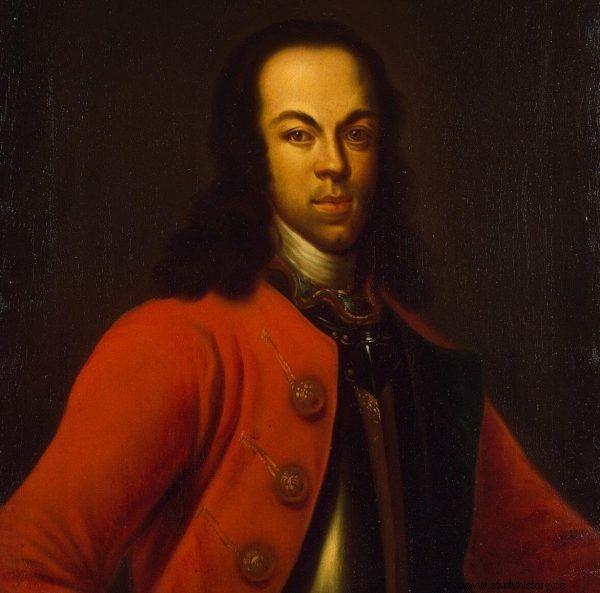
Aleksy was the only child of Piotr for several years. However, my father made sure that he never felt like a 100% heir to the throne (source:public domain).
Piotr knew that his son was surrounded by reluctant people. So he sent him to Saxony in 1709 to cut off from their influence and marry a German princess. Alexios agreed, but corresponded constantly with Ignatiev.
The tsar gave his son the title of "bombing squad soldier". The boy, however, was afraid of the battlefield, and he ran away from the pressure into alcohol. He did not manage to avoid marriage. In 1711 he married Sophie Charlotte of Brunswick, a relative of the future Emperor Charles VI.
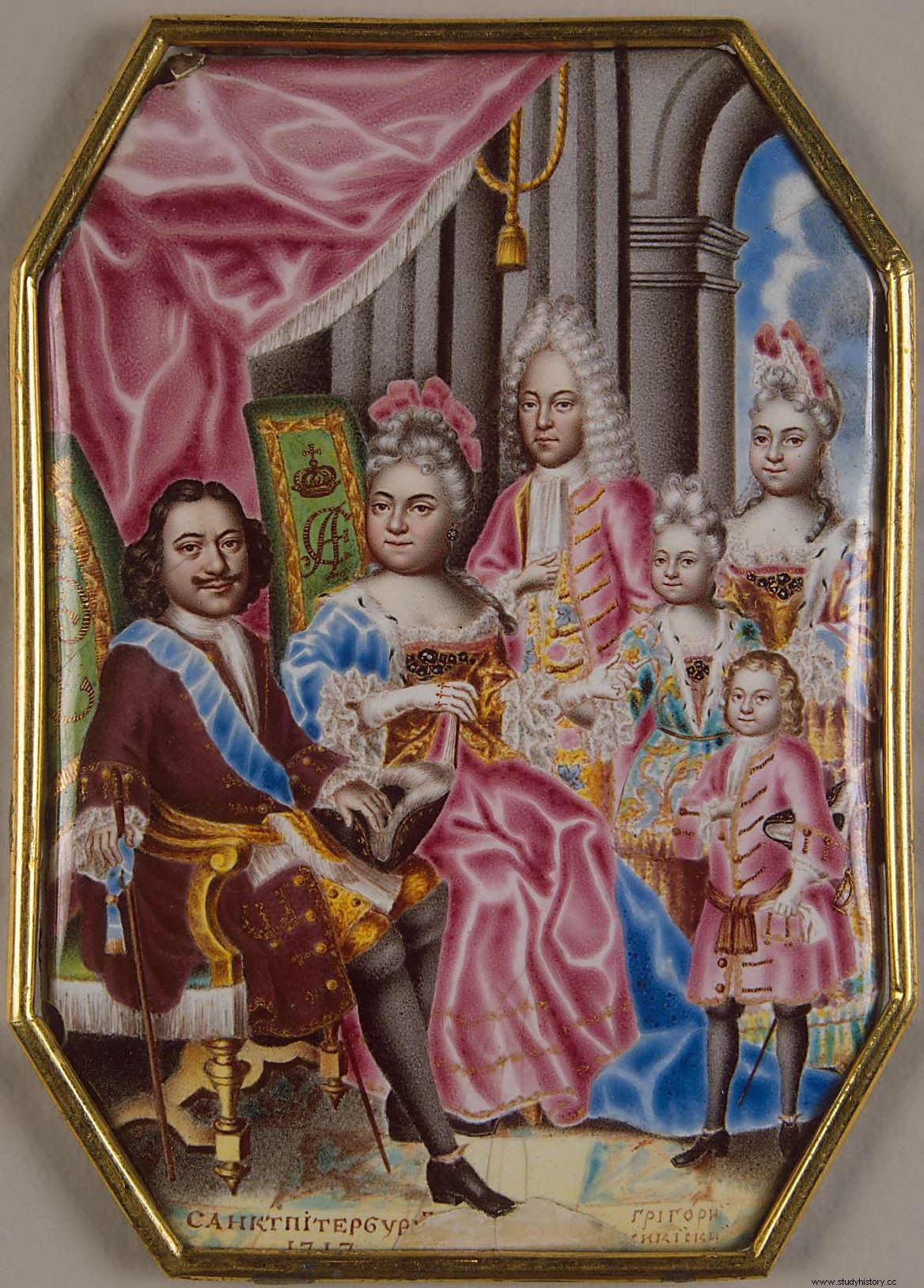
Happy, compatible family? Exactly. Tsarevich Alexy (in the center, in the back) was in deep conflict with his father and stepmother, and he treated his half-siblings (Anna, Elizabeth and Piotr from the back) as a threat to his position. Enamel on copper, the work of Grigory Semenovich Musikijski from 1716 or 1717 (source:public domain).
Tsarevich was concerned about his father's remarriage with a peasant girl, Katarzyna Skowrońska. Relations worsened in 1715, when the tsar's second son, Peter, was born, and Alexius' wife died. On the day of Charlotte's funeral, the Tsarevich received a letter from his father that he was to deal with the affairs of the state under the threat of losing his rights to the throne . Alexios, fearing his father's wrath, renounced his inheritance.
Go to Vienna!
Piotr was not satisfied. In January 1716 gave his son an ultimatum - cooperation and succession to the throne, or a monk future . Kikin advised Alexei to go to the monastery because the monks' cap is not nailed to the head and can always be removed . Piotr, however, decided to decide on his son's future after returning from abroad.
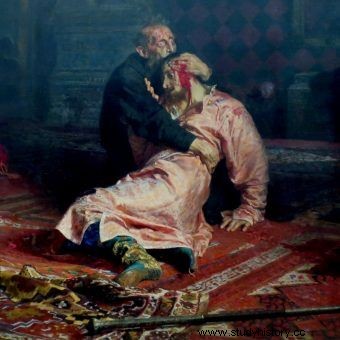
The painting entitled "Tsar Ivan the Terrible and his son Ivan, November 16, 1581" Ilya Riepin
Overjoyed Aleksy began to think about marrying his lover, the peasant Eufrozyna . He did not enjoy it for long. After his departure, the tsar asked his son to come to him in Copenhagen, or to go to the monastery.
In 1716, Alexius and his lover left Russia, but not for Denmark, but ... Vienna. He must have hoped that he would free himself from his paternal authority and that he would return in glory after the tsar's death. Kikin, the main organizer of the escapade, enlisted the support of Charles VI, who sheltered Alexius at Ehrenberg Castle in Tirol.
You will not run away from Russian intelligence
When Peter found out that Alexius had fled, he ordered him to be found. He asked the emperor to hand over his son. He sent the captain of the guard, Alexander Rumyantsev, who quickly discovered Alexius' whereabouts. The Austrian court secretly sent the Tsarevich to Naples, but this did not confuse Rumyantsev.
Together with Piotr Tolstoy, he threatened that if he refused to meet Aleksei, relations between the states would be severed and Silesia was invaded . Charles VI bowed to such pressure.
The meeting of the tsar's envoys with Alexei took place on September 26, 1717. Influenced by promises of full paternal grace, persuasion and threats, Alexius agreed to return. However, he had a condition that the tsar would allow him to settle in the countryside and marry Euphrozyna.
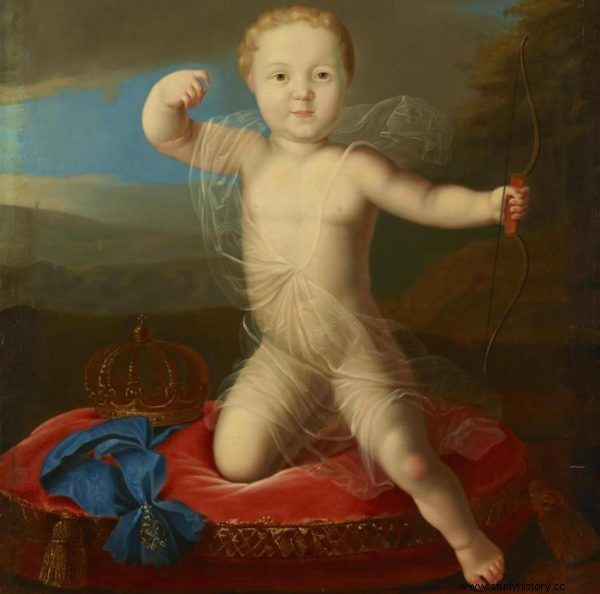
After returning to the country, Alexios lost the throne to his half-brother, Peter. Mały Piotr Piotrowicz as a cupid (source:public domain).
On February 3, 1718 in the Kremlin Alexius fell at his father's feet, and the tsar promised him a favor in return for revealing his associates . In the event of concealing anything, the Tsarevitch agreed to punish him with the death penalty. He was also deprived of the rights to the throne - his new stepbrother, Piotr, was his new successor.
Investigation in the Russian style
The tsar established a special tribunal, the Secret Chancellery of Investigative Affairs. The Tsarevich was given a list of people helping him in his escape to be signed. Alexius, giving the names of the conspirators, condemned them to death, believing that he would save his life. Ignatiev was arrested. Kikin was sentenced to breaking the wheel . Eudoxia was isolated from the world. Many courtiers were selected.
On March 18, Alexei left with his father to St. Petersburg, asking for permission to marry. The soon-to-come Euphrosyne was arrested instead of the wedding party . She confessed that the lover had spoken of his reign after the overthrow of his father and was glad to hear of his brother's illness. At first, Alexei denied her testimony, but soon revealed secret plans. This significantly changed the situation, because until now the tsar treated his son only as a tool of the opposition.
Kiss of death
On June 13, Peter called the clergy, generals and senators to bring the case to trial. The clergy replied in Solomon that The heart of the tsar is in God's hands, as the tsar decides, it will be fair .
The laity decided to investigate the matter first. The next day, the Tsarevich went to the newly built Peter and Paul Fortress. During the investigation, he was tortured to the point that he lost consciousness many times.
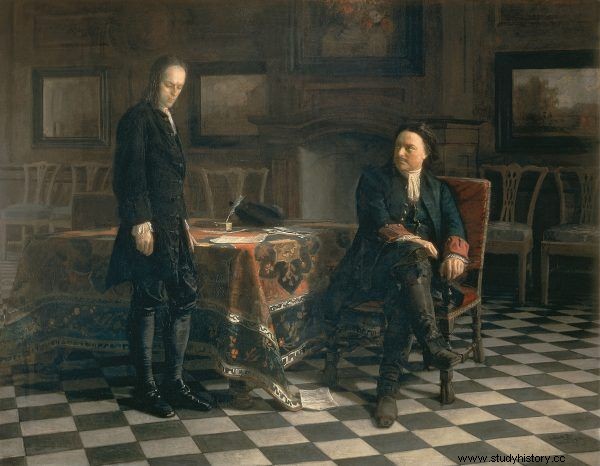
Alexius could not count on paternal pity or grace. A painting by Nikolai Gay from 1871 showing Peter the Great interrogating his son. In this case, even without torture (source:public domain).
On June 25, the court pronounced Alexei guilty of crimes against the Tsar and his father and condemned him to death. At the end of the trial, the tsar embraced his son and kissed his lips like Judas.
Unexplained circumstances
After hearing the verdict, Alexius lost consciousness. He died in the dungeons of the Peter and Paul Fortress the day after the sentence. Many myths arose around his death. Some said his father had cut his head off. Others said he was to be shot, but the platoon refused to obey the order, and the tsarevich was killed by one of the officers. There were also suspicions of poisoning, ineffective help with an apoplexy attack, internal hemorrhage or a bayonet puncture.
The most credible messages as the cause of death indicate suffocation with pillows or injuries sustained during torture, allegedly in the presence of the Tsar and Rumyantsev.
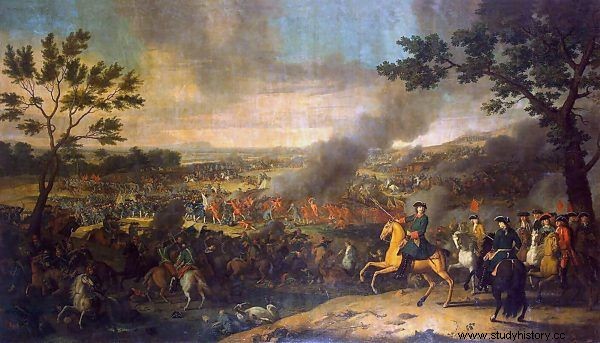
What the death of a son! Such a detail cannot spoil the event on the ninth anniversary of the victorious Battle of Poltava. Louis Caravaqe's painting depicting this famous clash, taken during the investigation against Alexius (source:public domain).
Alexius was buried in the tsarist crypt. Significantly, the death of his son did not prevent Piotr from having fun on the anniversary of the Poltava victory .
Piotr Piotrowicz died a year after his stepbrother. The male lineage soon became extinct, and women took over the reign of power in Russia for the next seventy years.
***
Although "only" two of Russia's rulers had the blood of their sons on their hands, they were not the only ones thinking about getting rid of their successors. Paul I was afraid to leave the country all his life so that his mother, Catherine II, would not disinherit him. As ruler himself, he intended to get rid of his successor, Alexander I. Before he did so, he was murdered by his son's followers.
